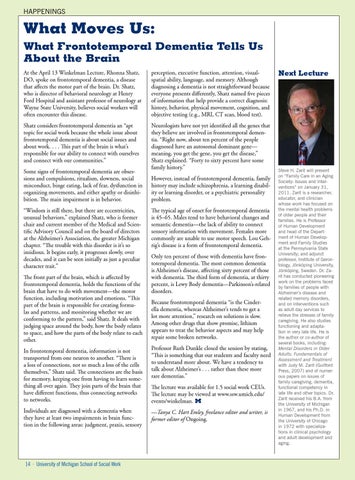FEATURE HAPPENINGS
What Moves Us: What Frontotemporal Dementia Tells Us About the Brain At the April 13 Winkelman Lecture, Rhonna Shatz, DO, spoke on frontotemporal dementia, a disease that affects the motor part of the brain. Dr. Shatz, who is director of behavioral neurology at Henry Ford Hospital and assistant professor of neurology at Wayne State University, believes social workers will often encounter this disease.
perception, executive function, attention, visualspatial ability, language, and memory. Although diagnosing a dementia is not straightforward because everyone presents differently, Shatz named five pieces of information that help provide a correct diagnosis: history, behavior, physical movement, cognition, and objective testing (e.g., MRI, CT scan, blood test).
Shatz considers frontotemporal dementia an “apt topic for social work because the whole issue about frontotemporal dementia is about social issues and about work. . . . This part of the brain is what’s responsible for our ability to connect with ourselves and connect with our communities.”
Neurologists have not yet identified all the genes that they believe are involved in frontotemporal dementia. “Right now, about ten percent of the people diagnosed have an autosomal dominant gene— meaning, you get the gene, you get the disease,” Shatz explained. “Forty to sixty percent have some family history.”
Some signs of frontotemporal dementia are obsessions and compulsions, ritualism, slowness, social misconduct, binge eating, lack of fear, dysfunction in organizing movements, and either apathy or disinhibition. The main impairment is in behavior. “Wisdom is still there, but there are eccentricities, unusual behaviors,” explained Shatz, who is former chair and current member of the Medical and Scientific Advisory Council and on the board of directors at the Alzheimer’s Association, the greater Michigan chapter. “The trouble with this disorder is it’s so insidious. It begins early, it progresses slowly, over decades, and it can be seen initially as just a peculiar character trait.” The front part of the brain, which is affected by frontotemporal dementia, holds the functions of the brain that have to do with movement—the motor function, including motivation and emotions. “This part of the brain is responsible for creating formulas and patterns, and monitoring whether we are conforming to the pattern,” said Shatz. It deals with judging space around the body, how the body relates to space, and how the parts of the body relate to each other.
However, instead of frontotemporal dementia, family history may include schizophrenia, a learning disability or learning disorder, or a psychiatric personality problem. The typical age of onset for frontotemporal dementia is 45–65. Males tend to have behavioral changes and semantic dementia—the lack of ability to connect sensory information with movement. Females more commonly are unable to use motor speech. Lou Gehrig’s disease is a form of frontotemporal dementia. Only ten percent of those with dementia have frontotemporal dementia. The most common dementia is Alzheimer’s disease, affecting sixty percent of those with dementia. The third form of dementia, at thirty percent, is Lewy Body dementia—Parkinson’s-related disorders. Because frontotemporal dementia “is the Cinderella dementia, whereas Alzheimer’s tends to get a lot more attention,” research on solutions is slow. Among other drugs that show promise, lithium appears to treat the behavior aspects and may help repair some broken networks.
In frontotemporal dementia, information is not transported from one neuron to another. “There is a loss of connections, not so much a loss of the cells themselves,” Shatz said. The connections are the basis for memory, keeping one from having to learn something all over again. They join parts of the brain that have different functions, thus connecting networks to networks.
Professor Ruth Dunkle closed the session by stating, “This is something that our students and faculty need to understand more about. We have a tendency to talk about Alzheimer’s . . . rather than these more rare dementias.”
Individuals are diagnosed with a dementia when they have at least two impairments in brain function in the following areas: judgment, praxis, sensory
—Tanya C. Hart Emley, freelance editor and writer, is former editor of Ongoing.
14 · University of Michigan School of Social Work
The lecture was available for 1.5 social work CEUs. The lecture may be viewed at www.ssw.umich.edu/ events/winkelman.
Next Lecture
Steve H. Zarit will present on “Family Care in an Aging Society: Issues and Interventions” on January 31, 2011. Zarit is a researcher, educator, and clinician whose work has focused on the mental health problems of older people and their families. He is Professor of Human Development and head of the Department of Human Development and Family Studies at the Pennsylvania State University; and adjunct professor, Institute of Gerontology, Jönköping University, Jönköping, Sweden. Dr. Zarit has conducted pioneering work on the problems faced by families of people with Alzheimer’s disease and related memory disorders, and on interventions such as adult day services to relieve the stresses of family caregiving. He also studies functioning and adaptation in very late life. He is the author or co-author of several books, including: Mental Disorders in Older Adults: Fundamentals of Assessment and Treatment with Judy M. Zarit (Guilford Press, 2007) and of numerous papers on issues of family caregiving, dementia, functional competency in late life and other topics. Dr. Zarit received his B.A. from the University of Michigan in 1967, and his Ph.D. in Human Development from the University of Chicago in 1972 with specializations in clinical psychology and adult development and aging.
